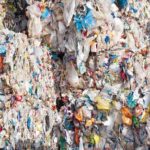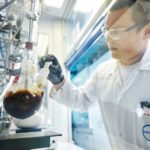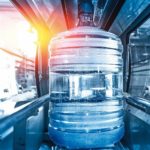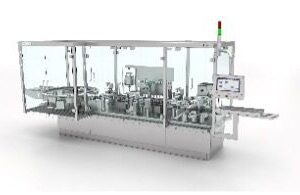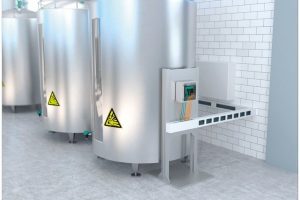Plastics are the material of our time: in the fight against climate change, for the development of new mobility concepts or to make our cities more liveable. However, in order to achieve a truly sustainable future and protect our environment in the long run, our attitude towards consumption and our understanding of waste must change. Since 1970, global resource consumption has more than tripled. The natural resources for the whole of 2020 were already exhausted after eight months. At the same time, humanity frequently does not deal with products in a sustainable way. According to a scientific study, only around 9 % of all plastics manufactured between 1950 and 2015 have been recycled – 600 million out of a massive 6.3 billion tons.
Produce, briefly consume, dispose – this pattern has had its day, in particular with regard to plastics. They must be used more and for longer. And at their end of life, they should be systematically and effectively reused and recycled.
Better recycling systems needed
However, much remains to be done to achieve an effective and resource-efficient circular economy. For example, worldwide waste and recycling systems must be improved or indeed set up. Currently, about two billion people – one quarter of the world’s population – do not have access to regular waste disposal. Yet change can only succeed if all market players work closely together. The plastics industry can – and wants – to play a decisive role in this, for instance in the Alliance to End Plastic Waste, a global coalition of companies of which BASF, Covestro and Henkel, amongst others, are members.
As one of the pioneers of the circular economy, Covestro wants to promote recycling of plastics. In more than 20 projects, experts at the company are working to make innovative technologies market-ready as soon as possible. In particular, the aim is to reduce the carbon footprint of production processes and products while contributing to climate and environmental protection. At the same time, Covestro is keen to develop new circular business models with customers and partners.
The newcomer: Chemical recycling
Mattresses give us a comfortable night’s sleep. Unfortunately, at the end of their lives, they are usually burned or end up in a depot – a destiny they share with many other plastic products. The average amount of polyurethane foam in a mattress is round about 15 to 20 kg. But there is hope yet: chemical recycling, which is still in its early stages, allows such materials to be recycled. During chemical recycling, foams and other plastics are split into their molecules and starting materials in order to manufacture new products.
With certain plastics, chemical recycling is the only sensible method of recycling. It must therefore be further developed and promoted. This also requires the right political and regulatory framework. The goal is to make chemical recycling an integral part of the plastics value chain – with all the advantages and disadvantages that this technology entails.
Pilot plant for PU foam recycling
Covestro has recently also been operating a pilot plant for flexible foam recycling, in order to verify the positive laboratory results achieved to date. Thanks to this project on chemical recycling of PU mattress foam, the company has made significant progress towards the goal of a recycling loop. “The project is part of a long-term strategic programme to fully align Covestro with the circular economy and be a driving force in value creation”, says Dr. Klaus Schäfer, Covestro’s Chief Technology Officer. “The development of this innovative recycling technology and the investment in the pilot plant are further milestones on the way to closing material loops. Our objective here is to replace fossil resources in production, reduce the carbon footprint of our materials and create solutions for dealing with plastic waste. At the same time, we succeeded in proving that polyurethanes are recyclable.”
Next-level foam recycling
“Our goal is to industrialise chemical recycling processes for post-consumer flexible foams, in order to ultimately commercialise both raw materials derived from recycling mattress foam”, explains Karin Clauberg, Venture Manager Flexible Foam Chemolysis at Covestro. “With our technology we’re aiming to deliver a high-purity, high-quality recycled polyol that fulfils customer specifications as well as a recycled toluene diamine, or TDA, which is suitable for further processing to toluene diisocyanate. This isocyanate, or TDI for short, is used together with the polyol for the production of flexible foams.”
Furthermore, in collaboration with Recticel and Redwave – a division of Wolfgang Binder GmbH – and as part of the PUReSmart research project, Covestro has developed an intelligent sorting solution to separate the different PU foams efficiently from post-consumer mattresses. The software uses machine-learning algorithms for proper recognition of the different types of foam, enabling clean material inputs for the subsequent recycling process. It represents a further component of the digitalisation strategy, with associated new opportunities for the entire chemical and plastic value chain.
The classic: Mechanical recycling has much to offer
Mechanical recycling is the classic recycling method. Polycarbonate, for example, is predestined for this. It is a particularly light plastic, shatterproof, perfectly formable and a true all-rounder: polycarbonate is used universally – from lenses to headlights to stadium roofs. This high-performance plastic, which Covestro manufactures and continuously develops, has yet another advantage: it is easy to recycle. After being sorted, cleaned and separated, the used product is crushed to granules. These granules are then melted and processed into new plastic. Many Covestro products manufactured in such a way are already on the market, including polycarbonate blends for IT applications with up to 75 % recycled materials.
In 2000 in China, for instance, Covestro signed a cooperation agreement with two companies that focus on making high-quality new plastic parts from used polycarbonate water bottles. The beverage manufacturer Nongfu Spring takes the bottles back and delivers them to Ausell, a recycling specialist, where they are processed into granules. Finally, Covestro manufactures precursors for electronic and household appliances as well as car components. The aim is to recycle one million such 19-liter (5-gallon) water barrels per year.
New ways: Designing products for recycling
With screws, dozens of individual parts and different plastics, car headlights are usually very complex. This does not make it easy to recycle them at the end of their life, but Covestro has developed a concept that makes this possible – with one single type of plastic and only a few components. This is a good example of a new approach to the economy, namely to design products from the outset with the best possible recycling in mind.
The sample headlight is not only lightweight, which amongst other things increases the range of electric cars or lowers the exhaust gas output of combustion vehicles. It also consists of much fewer components than conventional models. And it is based on just one material: high-performance polycarbonate.
Guide to the electrical industry
In other sectors too, more and more attention is being paid to the use of recycled materials in end products. This applies, for instance, to the manufacturers of electrical and electronic equipment and household appliances. For them, Covestro has published the Circular Design Guidebook, a booklet produced in collaboration with Renato lab, the consulting firm, to help designers and developers make their products more circular.
The book shows which materials are best suited for making products as resource-efficient and sustainable as possible. It is also about circular thinking in terms of supply chains and business models as well as increasing resource productivity.
Conclusion
Companies like Covestro are working hard on solutions for plastics recycling. Even if many processes are still in their infancy, the first approaches are definitely recognisable. Overall, however, it will take a great deal of effort yet before we can speak of a complete circular economy. For example, many depolymerisation processes require enormous amounts of energy, which must be made available in a climate-neutral way. After all, it makes little sense to burn natural gas in order to break plastics back down into their raw materials.
Online search: plastics recycling
Dr. Bernd Rademacher
Editor
The Circular economy: How it works
The circular economy is a buzzword that is now an integral part of company reports and mission statements. But what exactly is it? In truth, the circular economy is much more than a buzzword – it is a system philosophy in which we no longer actually throw anything away. Instead, materials are preserved through reuse or recycling, with benefits for society and the environment.
The best way to understand the circular economy is to look at our current model, which the world has followed since the first industrial revolution: the linear economy. This is a “take, make, dispose” model: extracting resources that are used to produce goods and then throwing away the waste product. This is not only a waste of natural resources; it also leaves us with a major waste problem and leads to ever higher greenhouse gas emissions.
In short, the circular economy decouples economic activity from resource use, which harms the planet by removing waste from the system at every step. In doing so, the circular economy starts with a product’s design by ensuring that it is easy to recycle. The aim is to reduce unnecessary packaging and offer customers more sustainable options. At the same time, products must be easy to repair or refurbish, in order to extend their life and thus reduce waste. By collecting our entire waste and recycling as much as possible, we can recover the material value of products and prevent them from ending up in the environment. Once the material value of products has been recovered through recycling, the raw materials can be reused to make new products, reducing the use of new natural resources.
Implementing a circular economy therefore not only benefits the environment but also ensures long-term economic viability, with significant benefits for our society. Experts estimate that the circular economy will bring additional annual growth of 0.6 % and reduce CO2 emissions by 48 % in Europe by 2030.



